Determining the Effect of Inlet Flow Conditions on the Thermal Efficiency of a Flat Plate Solar Collector
Abstract
:1. Introduction
2. Model Description
2.1. Governing Equations
2.2. System Performance
2.3. Boundary Conditions
2.4. Geometry Description
3. Grid Independence
4. Model Validation
5. Results and Discussion
5.1. Effect of Flowrate on FPC Performance at High and Low Level of Inlet Temperature
5.2. Effect of Inlet Temperature on FPC Performance at High and Low Level of Flowrate:
5.3. Employing FPC Outlet Water Temperature for Solar Absorption Cooling System
5.4. Performance of FPC Versus Energy Loss Parameter
6. Conclusions
Author Contributions
Funding
Acknowledgments
Conflicts of Interest
References
- Martinopoulos, G. Energy efficiency and environmental impact of solar heating and cooling systems. In Advances in Solar Heating and Cooling, 1st ed.; Ge, T., Wang, R., Eds.; Woodhead Publishing: Sawston, Cambridge, UK, 2016; pp. 43–59. [Google Scholar]
- Shirazi, A.; Taylor, R.A.; Morrison, G.L.; White, S.D. Solar-powered absorption chillers: A comprehensive and critical review. Energy Convers. Manag. 2018, 171, 59–81. [Google Scholar] [CrossRef]
- Settino, J.; Sant, T.; Micallef, C.; Farrugia, M.; Spiteri Staines, C.; Licari, J.; Micallef, A. Overview of solar technologies for electricity, heating and cooling production. Renew. Sustain. Energy Rev. 2018, 90, 892–909. [Google Scholar] [CrossRef]
- Lizarte, R.; Izquierdo, M.; Marcos, J.; Palacios, E. An innovative solar-driven directly air-cooled LiBr–H2O absorption chiller prototype for residential use. Energy Build. 2012, 47, 1–11. [Google Scholar] [CrossRef]
- Bellos, E.; Tzivanidis, C.; Antonopoulos, K.A. Exergetic, energetic and financial evaluation of a solar driven absorption cooling system with various collector types. Appl. Therm. Eng. 2016, 102, 749–759. [Google Scholar] [CrossRef]
- Praene, J.P.; Marc, O.; Lucas, F.; Miranville, F. Simulation and experimental investigation of solar absorption cooling system in Reunion Island. Appl. Energy 2011, 88, 831–839. [Google Scholar] [CrossRef]
- Aman, J.; Ting, D.-K.; Henshaw, P. Residential solar air conditioning: Energy and exergy analyses of an ammonia–water absorption cooling system. Appl. Therm. Eng. 2014, 62, 424–432. [Google Scholar] [CrossRef] [Green Version]
- Li, Z.; Ye, X.; Liu, J. Optimal temperature of collector for solar double effect LiBr/H2O absorption cooling system in subtropical city based on a year round meteorological data. Appl. Therm. Eng. 2014, 69, 19–28. [Google Scholar] [CrossRef]
- Calise, F.; d’Accadia, M.D.; Palombo, A.; Vanoli, L. Dynamic simulation of a novel high-temperature solar trigeneration system based on concentrating photovoltaic/thermal collectors. Energy 2013, 61, 72–86. [Google Scholar] [CrossRef]
- Mateus, T.; Oliveira, A.C. Energy and economic analysis of an integrated solar absorption cooling and heating system in different building types and climates. Appl. Energy 2009, 86, 949–957. [Google Scholar] [CrossRef]
- Martínez, P.J.; Martínez, J.C.; Lucas, M. Design and test results of a low-capacity solar cooling system in Alicante (Spain). Solar Energy 2012, 86, 2950–2960. [Google Scholar] [CrossRef]
- Fong, K.; Chow, T.T.; Lee, C.K.; Lin, Z.; Chan, L. Solar hybrid cooling system for high-tech offices in subtropical climate–Radiant cooling by absorption refrigeration and desiccant dehumidification. Energy Convers. Manag. 2011, 52, 2883–2894. [Google Scholar] [CrossRef]
- Agrouaz, Y.; Bouhal, T.; Allouhi, A.; Kousksou, T.; Jamil, A.; Zeraouli, Y. Energy and parametric analysis of solar absorption cooling systems in various Moroccan climates. Case Stud. Therm. Eng. 2017, 9, 28–39. [Google Scholar] [CrossRef]
- Martínez, P.J.; Martínez, J.C.; Martínez, P. Performance comparison of solar autonomous and assisted absorption systems in Spain. Int. J. Refrig. 2016, 71, 85–93. [Google Scholar] [CrossRef]
- Marc, O.; Lucas, F.; Sinama, F.; Monceyron, E. Experimental investigation of a solar cooling absorption system operating without any backup system under tropical climate. Energy Build. 2010, 42, 774–782. [Google Scholar] [CrossRef]
- Sumathy, K.; Huang, Z.; Li, Z. Solar absorption cooling with low grade heat source—A strategy of development in South China. Solar Energy 2002, 72, 155–165. [Google Scholar] [CrossRef]
- Alobaid, M.; Hughes, B.; Calautit, J.K.; O’Connor, D.; Heyes, A. A review of solar driven absorption cooling with photovoltaic thermal systems. Renew. Sustain. Energy Rev. 2017, 76, 728–742. [Google Scholar] [CrossRef] [Green Version]
- Ketfi, O.; Merzouk, M.; Merzouk, N.K.; Metenani, S.E. Performance of a Single Effect Solar Absorption Cooling System (Libr-H2O). Energy Procedia 2015, 74, 130–138. [Google Scholar] [CrossRef]
- Fong, K.; Lee, C. Performance advancement of solar air-conditioning through integrated system design for building. Energy 2014, 73, 987–996. [Google Scholar] [CrossRef]
- Shirazi, A.; Taylor, R.A.; Morrison, G.L.; White, S.D. A comprehensive, multi-objective optimization of solar-powered absorption chiller systems for air-conditioning applications. Energy Convers. Manag. 2017, 132, 281–306. [Google Scholar] [CrossRef]
- Zhang, D.; Li, J.; Gao, Z.; Wang, L.; Nan, J. Thermal performance investigation of modified flat plate solar collector with dual-function. Appl. Therm. Eng. 2016, 108, 1126–1135. [Google Scholar] [CrossRef]
- Selmi, M.; Al-Khawaja, M.J.; Marafia, A. Validation of CFD simulation for flat plate solar energy collector. Renew. Energy 2008, 33, 383–387. [Google Scholar] [CrossRef]
- Villar, N.M.; López, J.M.C.; Muñoz, F.D.; García, E.R.; Andrés, A.C. Numerical 3-D heat flux simulations on flat plate solar collectors. Solar Energy 2009, 83, 1086–1092. [Google Scholar] [CrossRef]
- Martinopoulos, G.; Missirlis, D.; Tsilingiridis, G.; Yakinthos, K.; Kyriakis, N. CFD modeling of a polymer solar collector. Renew. Energy 2010, 35, 1499–1508. [Google Scholar] [CrossRef]
- Missirlis, D.; Martinopoulos, G.; Tsilingiridis, G.; Yakinthos, K.; Kyriakis, N. Investigation of the heat transfer behaviour of a polymer solar collector for different manifold configurations. Renew. Energy 2014, 68, 715–723. [Google Scholar] [CrossRef]
- Sekhar, T.V.R.; Nandan, G.; Prakash, R.; Muthuraman, M. Modeling a Renewable Energy Collector and Prediction in Different Flow Regimes Using CFD. Mater. Today Proc. 2018, 5, 4563–4574. [Google Scholar] [CrossRef]
- Rangababu, J.A.; Kumar, K.; Rao, S. Numerical Analysis and Validation of Heat Transfer Mechanism of Flat Plate Collectors. Procedia Eng. 2015, 127, 63–70. [Google Scholar] [CrossRef]
- Duffie, J.A.; Beckman, W.A. Solar Engineering of Thermal Processes; John Wiley & Sons Inc.: New York, NY, USA, 1980. [Google Scholar]
- Hajabdollahi, Z.; Hajabdollahi, H. Thermo-economic modeling and multi-objective optimization of solar water heater using flat plate collectors. Solar Energy 2017, 155, 191–202. [Google Scholar] [CrossRef]
- White, F.M. Fluid Mechanics, in SI Units, 7th ed.; McGraw Hill Higher Education: Columbus, OH, US, 2011. [Google Scholar]
- Calautit, J.K.; Chaudhry, H.N.; Hughes, B.R.; Ghani, S.A. Comparison between evaporative cooling and a heat pipe assisted thermal loop for a commercial wind tower in hot and dry climatic conditions. Appl. Energy 2013, 101, 740–755. [Google Scholar] [CrossRef]
- A nsys. CFD. In ICEM CFD Theory Guide; Ansys Inc.: Canonsburg, PA, USA, 2015. [Google Scholar]
- Chow, T.T. A review on photovoltaic/thermal hybrid solar technology. Appl. Energy 2010, 87, 365–379. [Google Scholar] [CrossRef]
- Dubey, S.; Tay, A.A. The theoretical modelling and optimization of a 10 KWP photovoltaic thermal system for a student hostel in Singapore. Int. J. Green Energy 2014, 11, 225–239. [Google Scholar] [CrossRef]
- Allouhi, A.; Kousksou, T.; Jamil, A.; Bruel, P.; Mourad, Y.; Zeraouli, Y. Solar driven cooling systems: An updated review. Renew. Sustain. Energy Rev. 2015, 44, 159–181. [Google Scholar] [CrossRef]
- Cerón, J.F.; Pérez-García, J.; Solano, J.P.; García, A.; Herrero-Martín, R. A coupled numerical model for tube-on-sheet flat-plate solar liquid collectors. Analysis and validation of the heat transfer mechanisms. Appl. Energy 2015, 140, 275–287. [Google Scholar] [CrossRef]
- Gunjo, D.G.; Mahanta, P.; Robi, P.S. CFD and experimental investigation of flat plate solar water heating system under steady state condition. Renew. Energy 2017, 106, 24–36. [Google Scholar] [CrossRef]
- Rejeb, O.; Sardarabadi, M.; Ménézo, C.; Passandideh-Fard, M.; Dhaou, M.H.; Jemni, A. Numerical and model validation of uncovered nanofluid sheet and tube type photovoltaic thermal solar system. Energy Convers. Manag. 2016, 110, 367–377. [Google Scholar] [CrossRef]
- Hung, T.-C.; Huang, T.-J.; Lee, D.-S.; Lin, C.-H.; Pei, B.-S.; Li, Z.-Y. Numerical analysis and experimental validation of heat transfer characteristic for flat-plate solar air collector. Appl. Therm. Eng. 2017, 111, 1025–1038. [Google Scholar] [CrossRef]
- Alobaid, M.; Hughes, B.; O’Connor, D.; Calautit, J.; Heyes, A. Improving Thermal and Electrical Efficiency in Photovoltaic Thermal Systems for Sustainable Cooling System Integration. J. Sustain. Dev. Energy Water Environ. Syst. 2018, 6, 305–322. [Google Scholar] [CrossRef] [Green Version]
- Shojaeizadeh, E.; Veysi, F.; Kamandi, A. Exergy efficiency investigation and optimization of an Al2O3–water nanofluid based Flat-plate solar collector. Energy Build. 2015, 101, 12–23. [Google Scholar] [CrossRef]

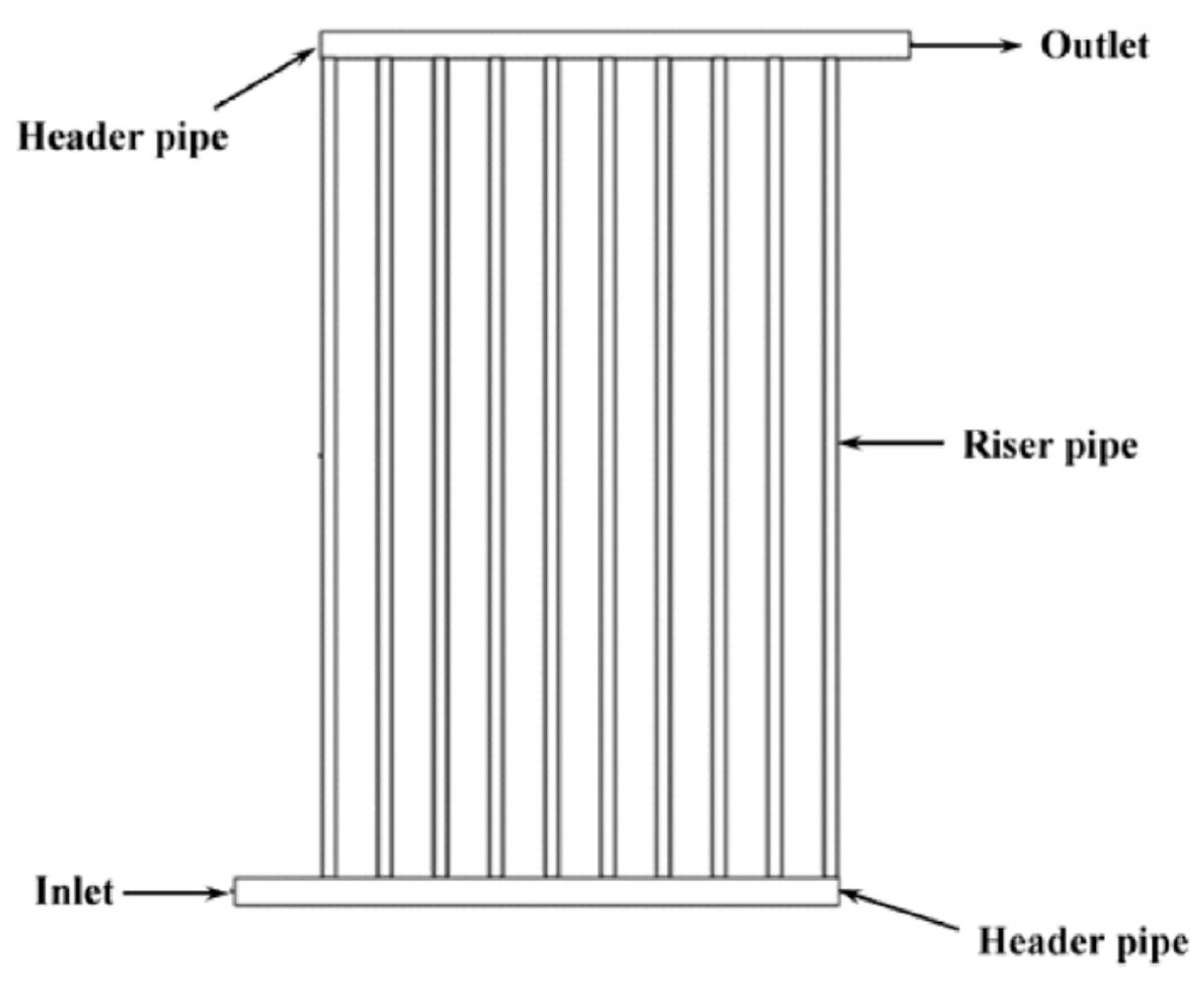

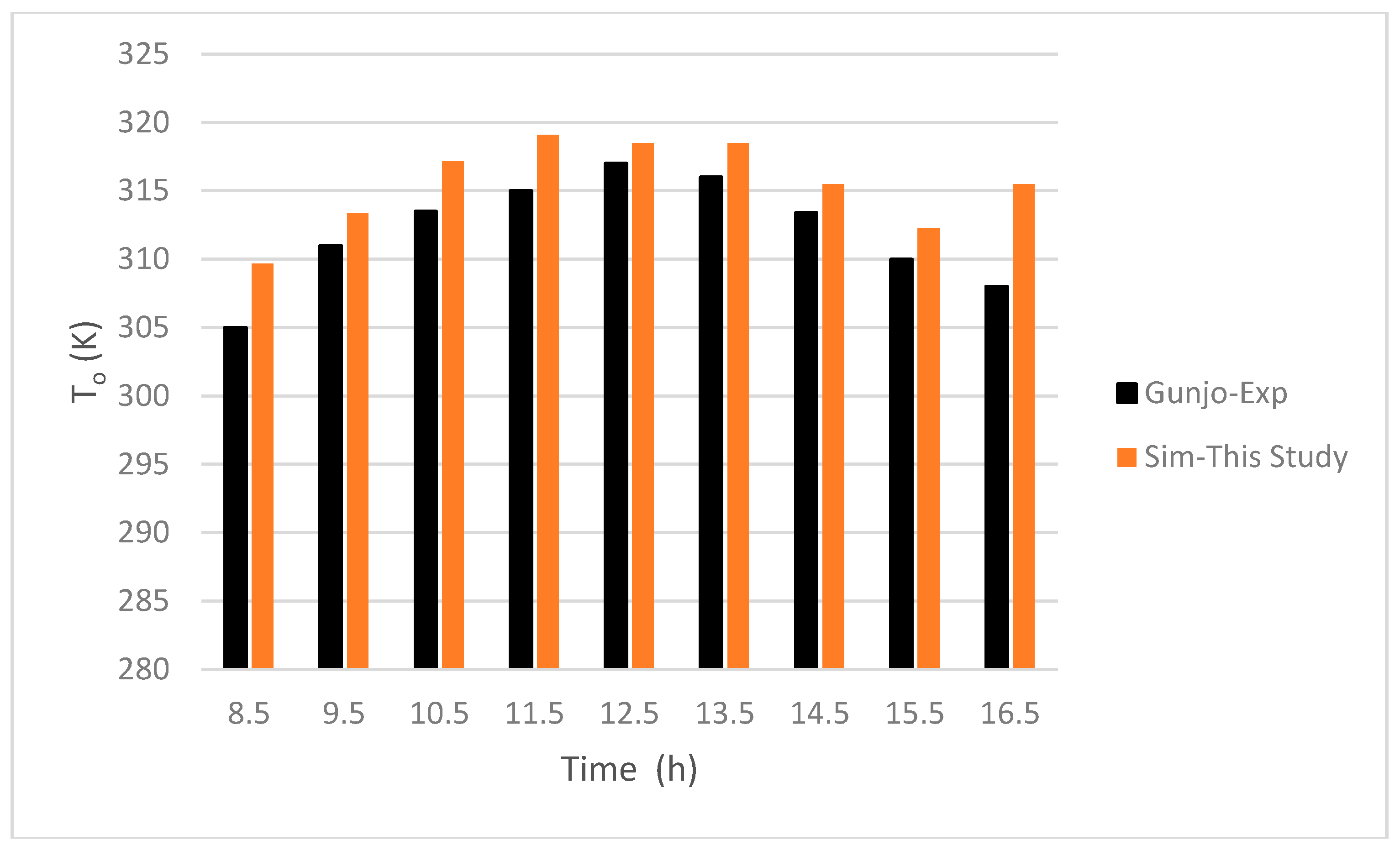
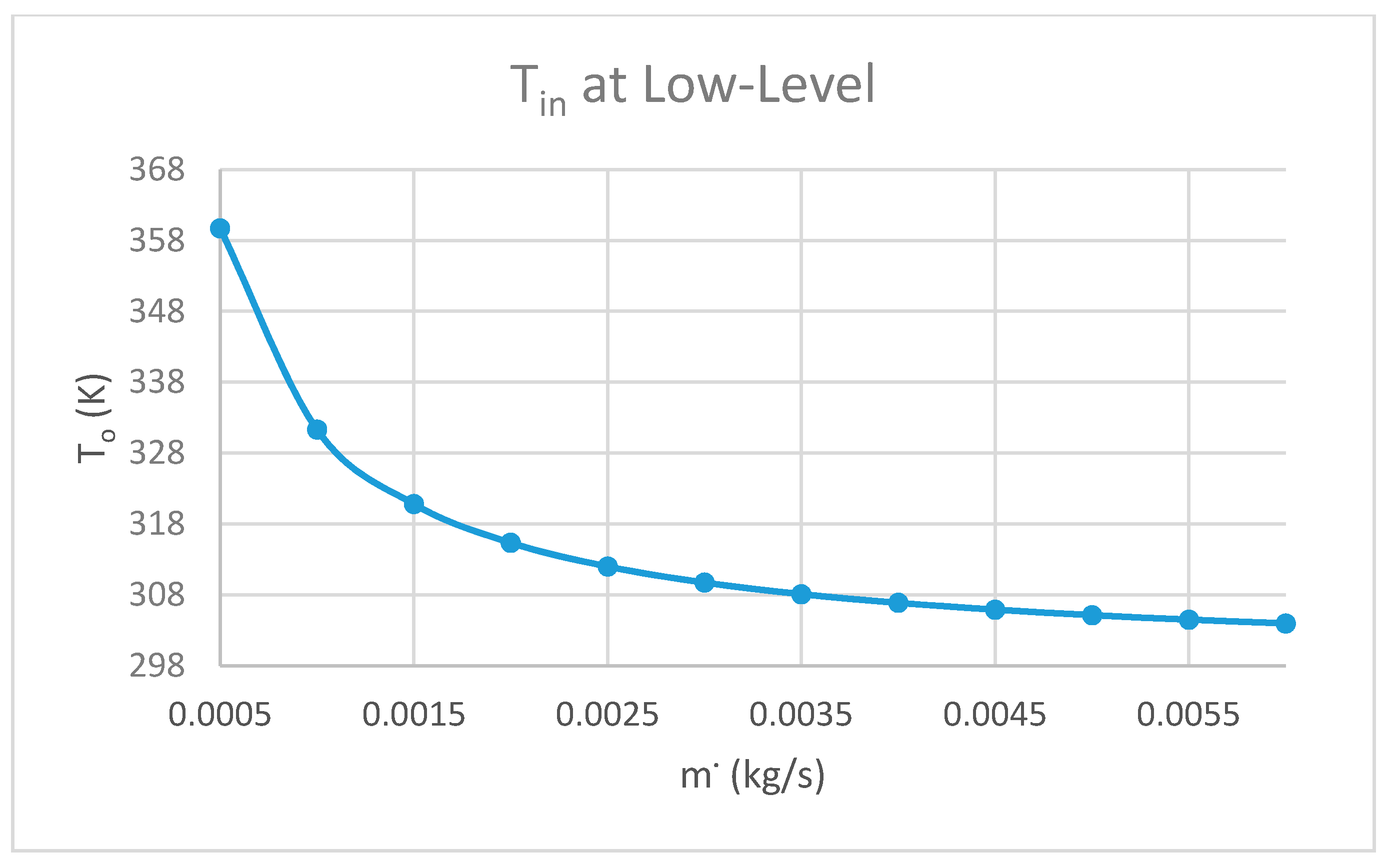
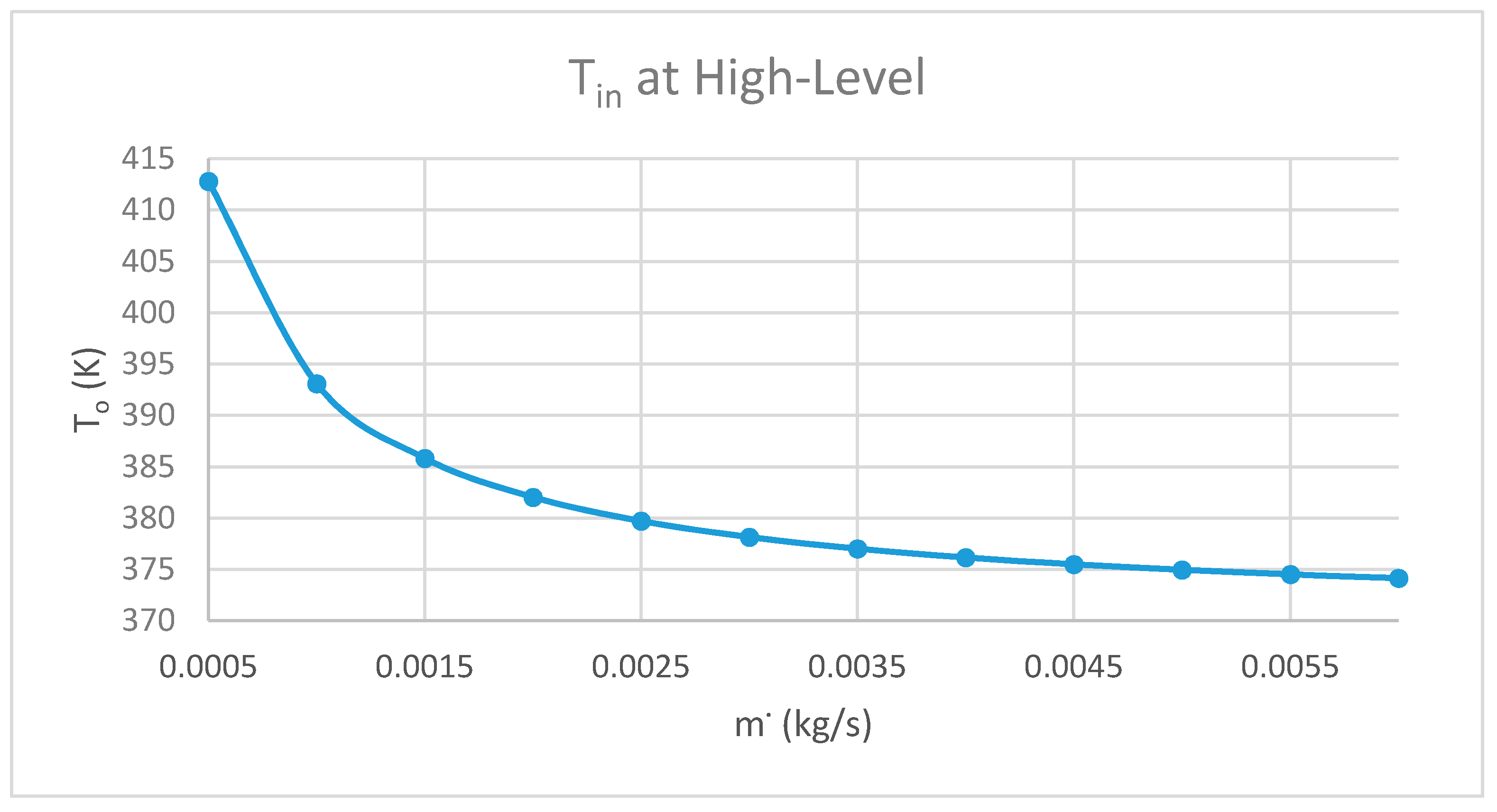
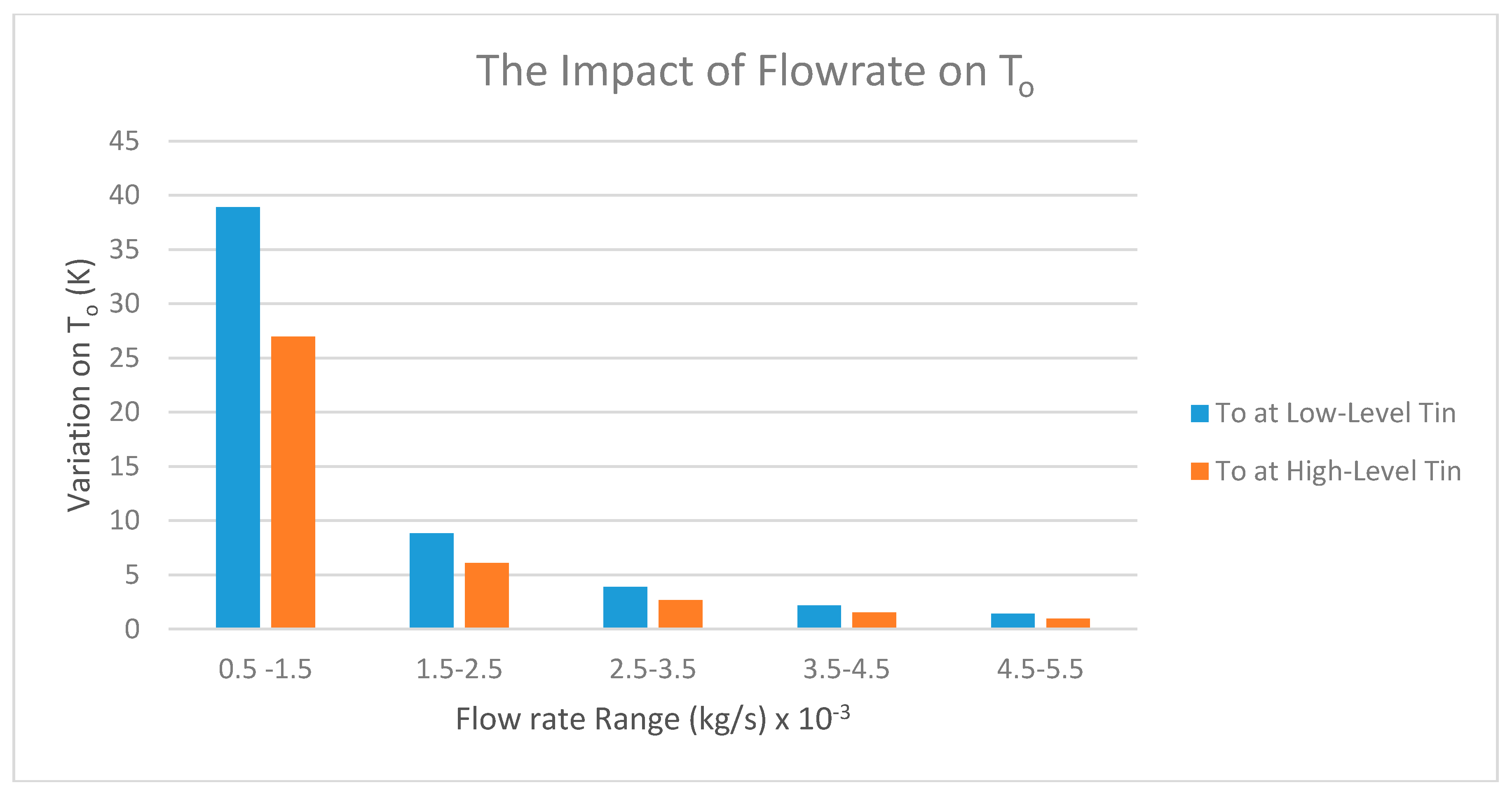
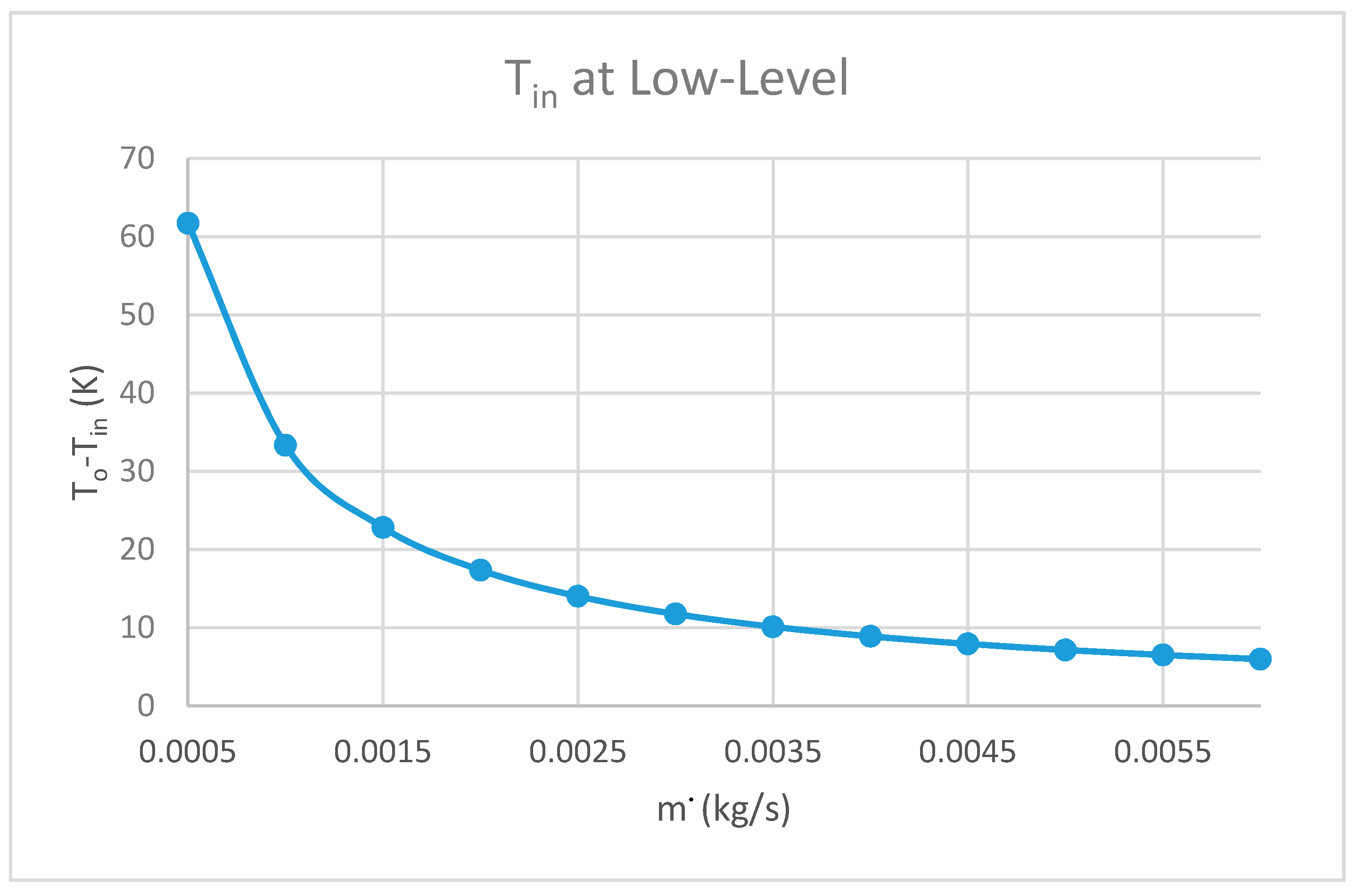

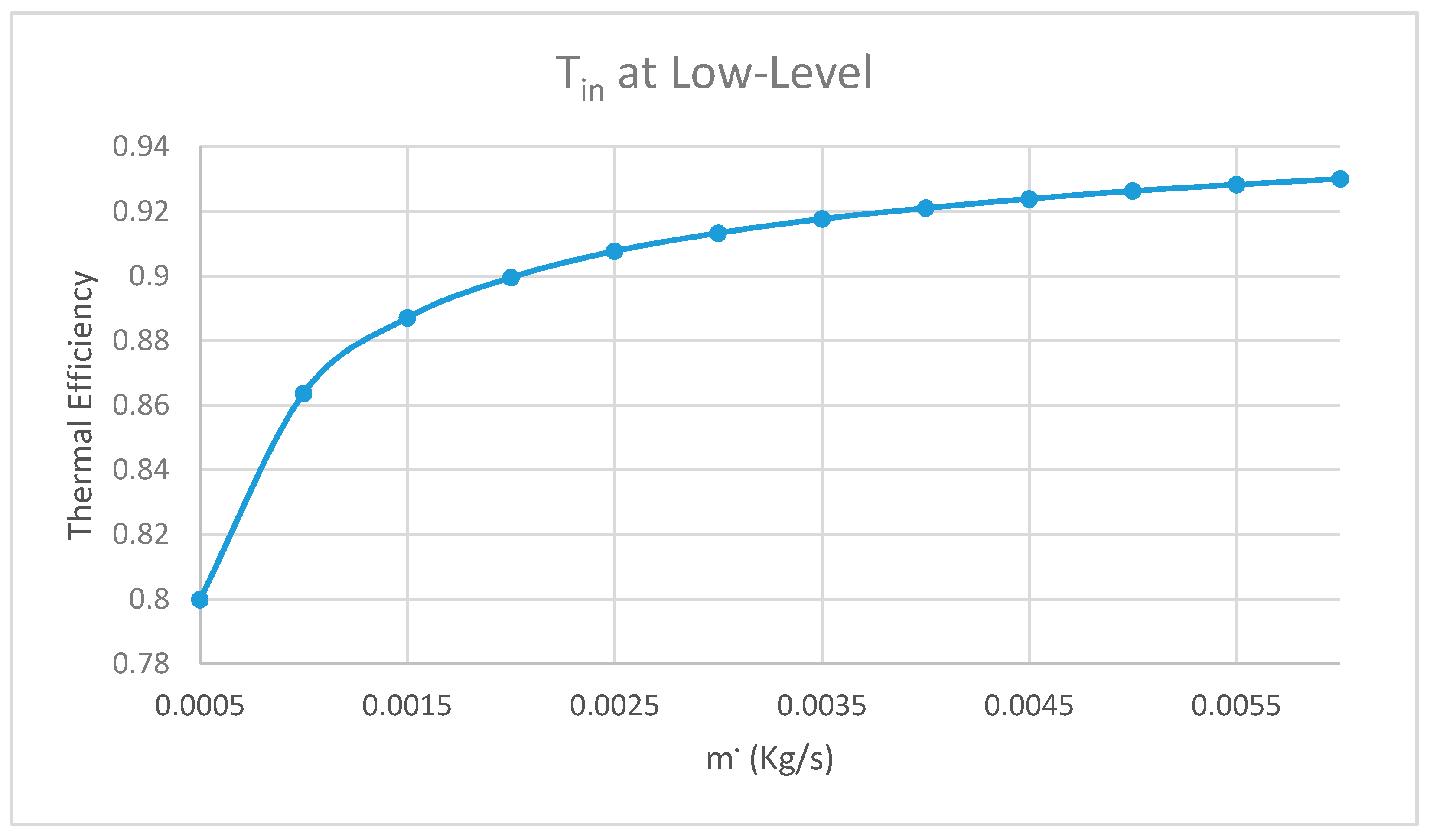

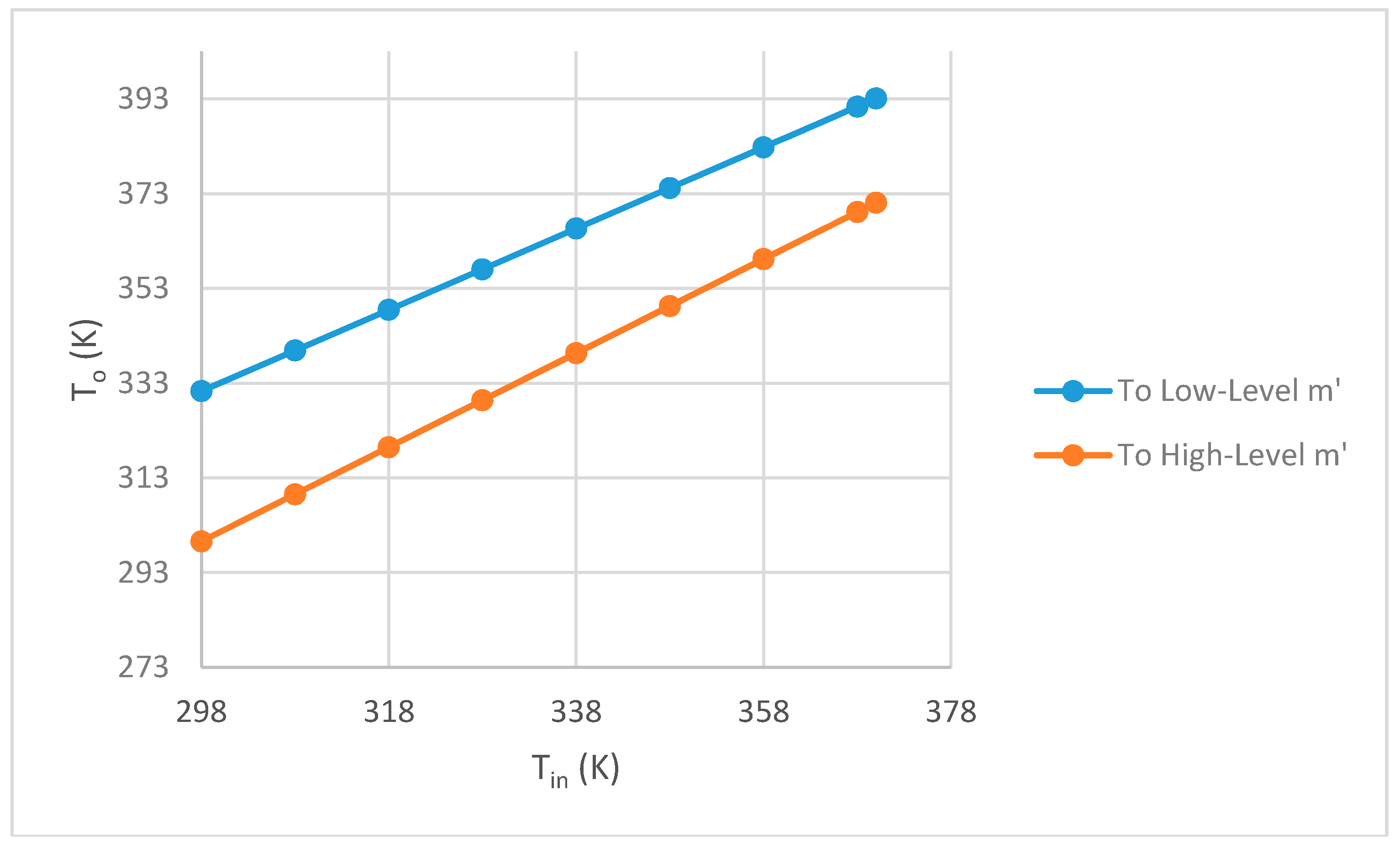
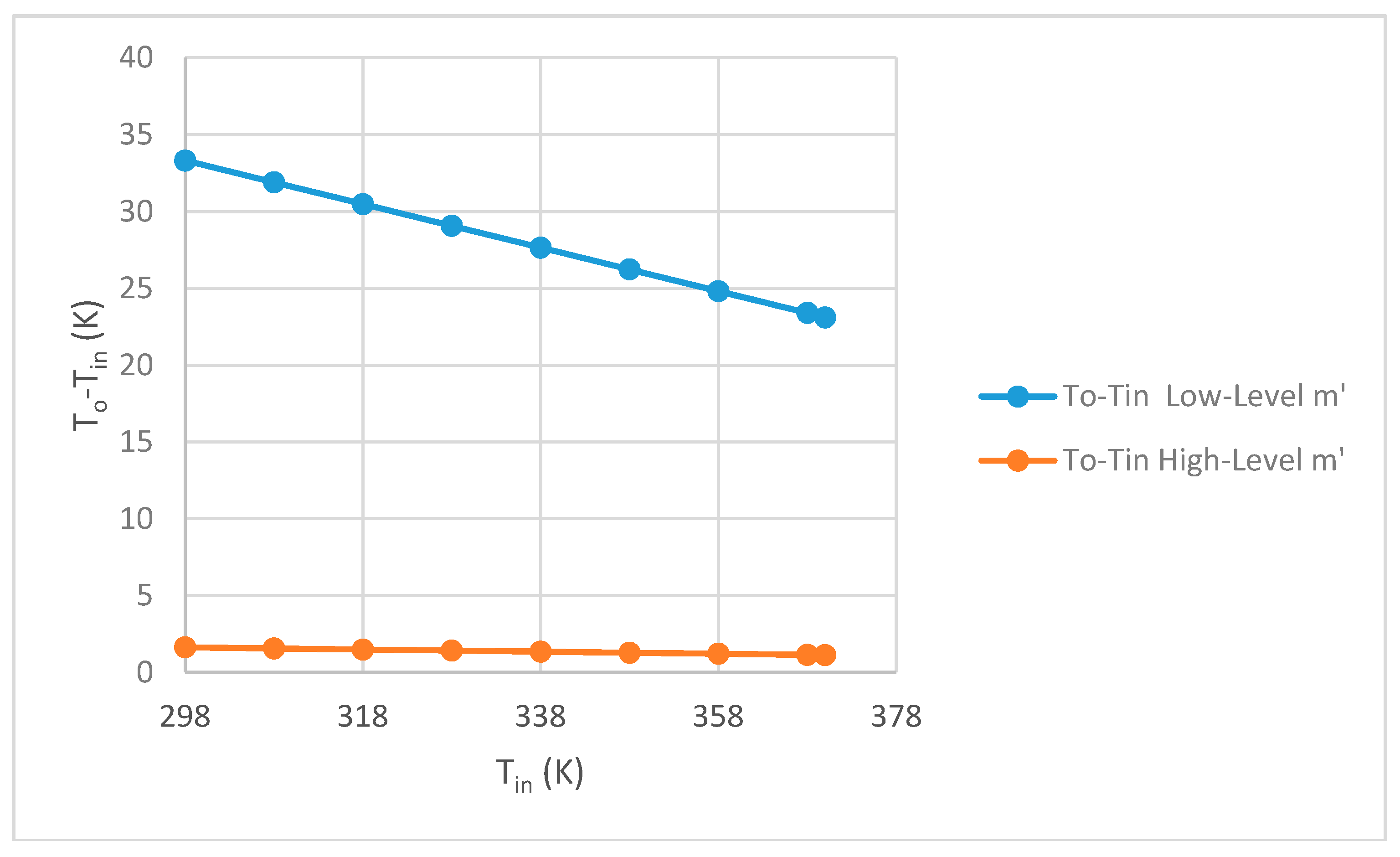
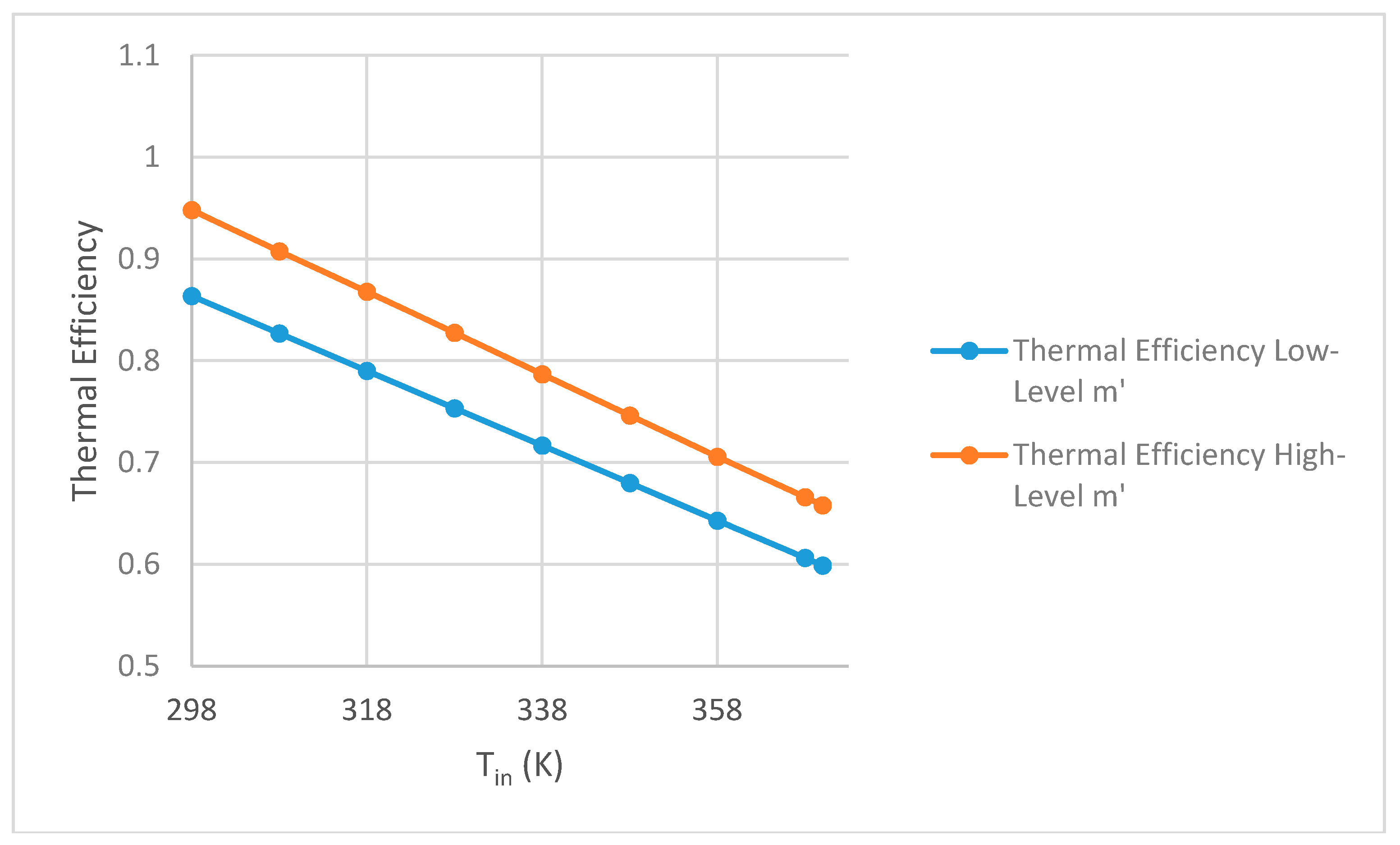
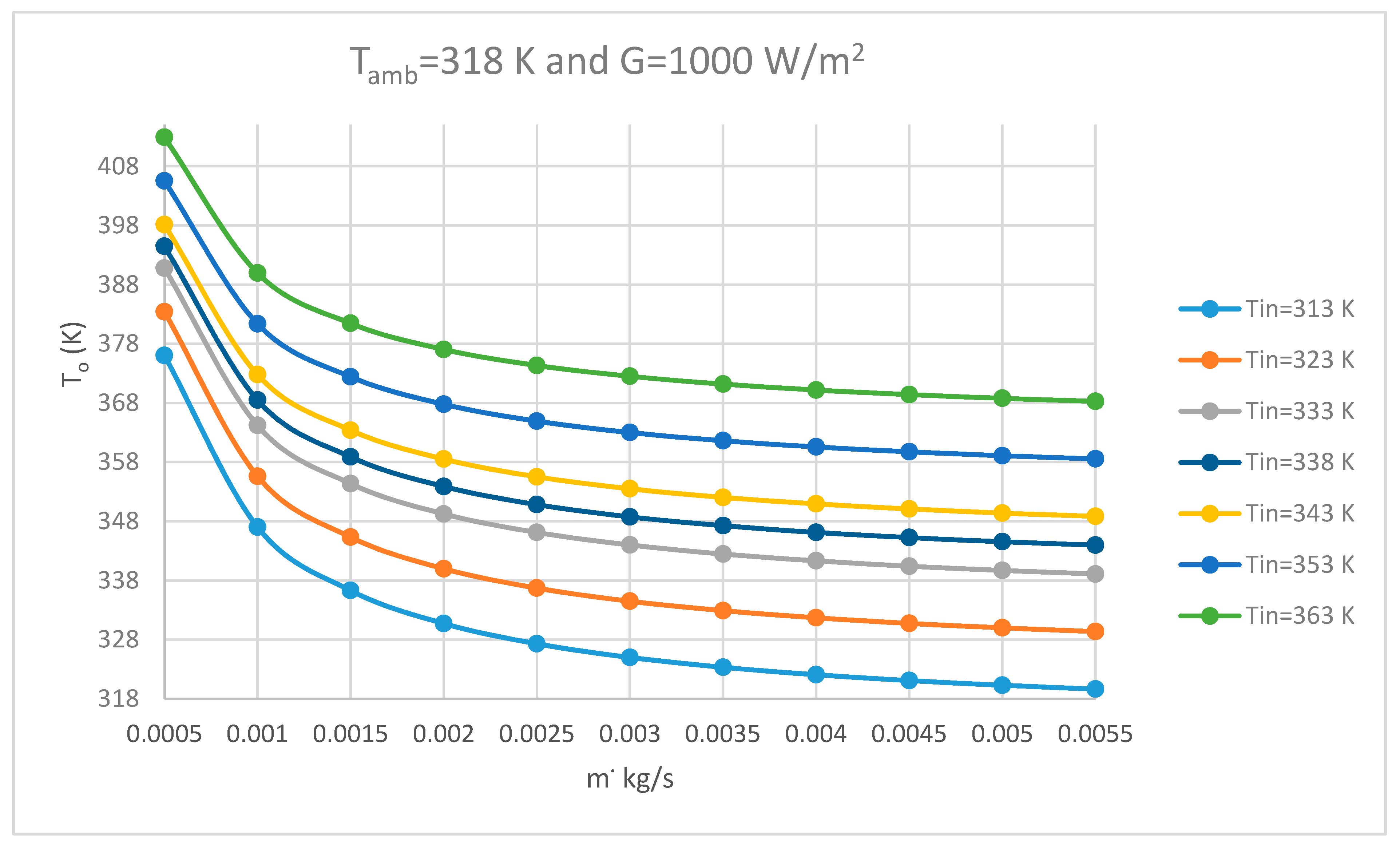


| Collector Type | Ac (m2) | Solar Collector Efficiency | Cooling Capacity(kW) | COP (Coefficient of Performance) | Method | Reference |
|---|---|---|---|---|---|---|
| FPC (computational studies) | 5–220 | 0.27–0.50 | 2.7–3 (m2/kWc) | 0.1–0.82 | TRANSYS | [10] |
| 37.5 | 4.5 | TRANSYS | [6] | |||
| 38.4 | 17.6 | TRANSYS | [11] | |||
| 100 | 2.6 | TRANSYS | [12] | |||
| N/A | 10 | Analytical method | [7] | |||
| 25 | 10 | Transol | [13] | |||
| 38.4 | 17.6 | TRANSYS | [14] | |||
| FPC (experimental studies) | 42.2 | 0.24–0.55 | 4.5 | 0.30–0.8 | Outdoor | [4] |
| 90 | 30 | Outdoor | [6] | |||
| 90 | 30 | Outdoor | [15] | |||
| 500 | 100 | Outdoor | [16] |
| Boundary | Condition |
|---|---|
| Inlet temperature (Tin) | 298 K (If it is not mentioned) |
| Outlet temperature (To) | Pressure outlet |
| Maximum mass flowrate | 0.0225 kg/s |
| Ambient temperature (Tamb) | 298 K |
| Side walls | Adiabatic walls |
| The absorber plate | Heat flux (q) = α·τ·G |
| The bottom layer | h = 2.8 + 3Vw |
| Wind speed | 1 m/s |
| Material | Density (kg/m3) | Thermal Conductivity (W/(m K)) | Heat Capacity (J/(kg K)) |
|---|---|---|---|
| Glass | 2500 | 1.4 | 750 |
| Absorber | 8954 | 386 | 385 |
| Insulation | 200 | 0.044 | 840 |
© 2018 by the authors. Licensee MDPI, Basel, Switzerland. This article is an open access article distributed under the terms and conditions of the Creative Commons Attribution (CC BY) license (http://creativecommons.org/licenses/by/4.0/).
Share and Cite
Alobaid, M.; Hughes, B.; Heyes, A.; O’Connor, D. Determining the Effect of Inlet Flow Conditions on the Thermal Efficiency of a Flat Plate Solar Collector. Fluids 2018, 3, 67. https://doi.org/10.3390/fluids3030067
Alobaid M, Hughes B, Heyes A, O’Connor D. Determining the Effect of Inlet Flow Conditions on the Thermal Efficiency of a Flat Plate Solar Collector. Fluids. 2018; 3(3):67. https://doi.org/10.3390/fluids3030067
Chicago/Turabian StyleAlobaid, Mohammad, Ben Hughes, Andrew Heyes, and Dominic O’Connor. 2018. "Determining the Effect of Inlet Flow Conditions on the Thermal Efficiency of a Flat Plate Solar Collector" Fluids 3, no. 3: 67. https://doi.org/10.3390/fluids3030067






